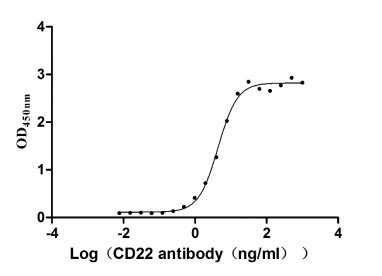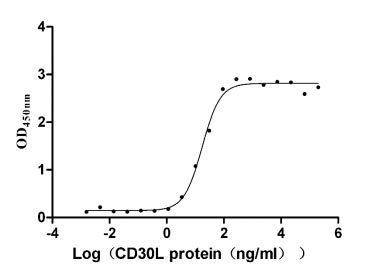Recombinant Mouse Transient receptor potential cation channel subfamily V member 3 (Trpv3), partial
-
中文名称:小鼠Trpv3重组蛋白
-
货号:CSB-YP817002MO1
-
规格:
-
来源:Yeast
-
其他:
-
中文名称:小鼠Trpv3重组蛋白
-
货号:CSB-EP817002MO1
-
规格:
-
来源:E.coli
-
其他:
-
中文名称:小鼠Trpv3重组蛋白
-
货号:CSB-EP817002MO1-B
-
规格:
-
来源:E.coli
-
共轭:Avi-tag Biotinylated
E. coli biotin ligase (BirA) is highly specific in covalently attaching biotin to the 15 amino acid AviTag peptide. This recombinant protein was biotinylated in vivo by AviTag-BirA technology, which method is BriA catalyzes amide linkage between the biotin and the specific lysine of the AviTag.
-
其他:
-
中文名称:小鼠Trpv3重组蛋白
-
货号:CSB-BP817002MO1
-
规格:
-
来源:Baculovirus
-
其他:
-
中文名称:小鼠Trpv3重组蛋白
-
货号:CSB-MP817002MO1
-
规格:
-
来源:Mammalian cell
-
其他:
产品详情
-
纯度:>85% (SDS-PAGE)
-
基因名:Trpv3
-
Uniprot No.:
-
别名:Trpv3; Transient receptor potential cation channel subfamily V member 3; TrpV3
-
种属:Mus musculus (Mouse)
-
蛋白长度:Partial
-
蛋白标签:Tag type will be determined during the manufacturing process.
The tag type will be determined during production process. If you have specified tag type, please tell us and we will develop the specified tag preferentially. -
产品提供形式:Lyophilized powder
Note: We will preferentially ship the format that we have in stock, however, if you have any special requirement for the format, please remark your requirement when placing the order, we will prepare according to your demand. -
复溶:We recommend that this vial be briefly centrifuged prior to opening to bring the contents to the bottom. Please reconstitute protein in deionized sterile water to a concentration of 0.1-1.0 mg/mL.We recommend to add 5-50% of glycerol (final concentration) and aliquot for long-term storage at -20℃/-80℃. Our default final concentration of glycerol is 50%. Customers could use it as reference.
-
储存条件:Store at -20°C/-80°C upon receipt, aliquoting is necessary for mutiple use. Avoid repeated freeze-thaw cycles.
-
保质期:The shelf life is related to many factors, storage state, buffer ingredients, storage temperature and the stability of the protein itself.
Generally, the shelf life of liquid form is 6 months at -20°C/-80°C. The shelf life of lyophilized form is 12 months at -20°C/-80°C. -
货期:Delivery time may differ from different purchasing way or location, please kindly consult your local distributors for specific delivery time.Note: All of our proteins are default shipped with normal blue ice packs, if you request to ship with dry ice, please communicate with us in advance and extra fees will be charged.
-
注意事项:Repeated freezing and thawing is not recommended. Store working aliquots at 4°C for up to one week.
-
Datasheet :Please contact us to get it.
相关产品
靶点详情
-
功能:Putative receptor-activated non-selective calcium permeant cation channel. It is activated by innocuous (warm) temperatures and shows an increased response at noxious temperatures greater than 39 degrees Celsius. Activation exhibits an outward rectification. May associate with TRPV1 and may modulate its activity. Is a negative regulator of hair growth and cycling: TRPV3-coupled signaling suppresses keratinocyte proliferation in hair follicles and induces apoptosis and premature hair follicle regression (catagen).
-
基因功能参考文献:
- results demonstrate that carvacrol from plant oregano is a skin sensitizer or allergen; TRPV3 is involved in the initial phase and the sustained phase of pruritus, whereas TRPA1 likely contributes to the initial phase. PMID: 29094727
- TRPV3 is involved in the development of ear edema caused by arachinonic acid. PMID: 28515378
- It was concluded that TRPV3 is expressed in a discrete subpopulation of vagal afferent neurons and may contribute to vagal afferent signaling either directly or in combination with TRPV1. PMID: 26843581
- findings suggest that although TRPV3 agonism induces hypothermia in rodents, it may have a limited potential as a novel pharmacological method for induction of hypothermia PMID: 26528923
- TRPV3 activation led to a decrease in embryonic stem cell proliferation. Cell cycle analysis revealed that TRPV3 activation increased the percentage of cells in G2/M phase. PMID: 26130157
- Study illustrates the antiadipogenic role of TRPV3 in the adipocytes. PMID: 25774551
- Investigated the role of TRPV3 to wound healing using a tooth extraction model and found that oral wound closure was delayed in TRPV3KO compared with that in WT. TRPV3 mRNA was up-regulated in wounded tissues, so TRPV3 may contribute to oral wound repair. PMID: 25351988
- Demonstrate similarities but also notable differences in TRPV3 pharmacology between recombinant and native systems. PMID: 23848361
- a gain-of-function mutation in TRPV3 (TRPV3Gly573Ser) shows that increasing skin temperature is associated with the modulation of dermal dendritic cells PMID: 24164484
- TRPV3-ARD with characteristic finger 3 loop likely plays an important role in channel function and pharmacology. PMID: 24248473
- This study demonistrated that Loss of interneuron long-term depression and attenuated pyramidal cell long-term potentiation in Trpv3 knockout mice PMID: 23536486
- temperature-dependent conformations of single amino acids in TRP channels PMID: 23555720
- Responses to camphor were totally lost in mTRPV3-C619S mutant. PMID: 23625413
- The findings suggest that epidermal TRPV3 is tonically inhibited by both extracellular and intracellular Mg(2+), which act on both sides of the channel pore loop. PMID: 22622423
- TRPV3 is a therapeutic target for itch PMID: 22475759
- TRPV3 regulates nitric oxide synthase-independent nitric oxide synthesis in the skin. PMID: 21712817
- TRPV3 and TRPV4 likely make limited and strain-dependent contributions to innocuous warm temperature perception or noxious heat sensation PMID: 21586160
- Study shows that keratinocyte TRPV3 forms a signaling complex with TGF-alpha/EGFR; activation of EGFR leads to increased TRPV3 channel activity, which in turn stimulates TGF-alpha release; TRPV3 is also required for the formation of the skin barrier. PMID: 20403327
- specifically expressed in keratinocytes;hence,skin cells are capable of detecting heat via molecules similar to those in heat-sensing neurons PMID: 12016205
- TRPV3 and TRPV4 are ion channels activated by modest increases in ambient temperature. PMID: 15004014
- activated by heat and expressed in keratinocytes; has a specific role in thermosensation; camphor proved to be a specific activator of TRPV3 PMID: 15746429
- TRPV3 was the gene responsible for Nh and Ht mutations, and mutation in TRPV3 possibly correlated with increased mast cell numbers. PMID: 16858425
- Data suggest that the G573S and G573C substitutions render the TRPV3 channel spontaneously active under normal conditions, which in turn alters ion homeostasis and membrane potentials of skin keratinocytes, leading to hair loss and skin diseases. PMID: 17706768
- Regulation of TRPV3 appears to be important for appropriate hair development in rodents. PMID: 17888882
- Ca(2+) inhibits TRPV3 from both the extracellular and intracellular sides. The inhibition is sequentially reduced, appearing as sensitization to repetitive stimulations. PMID: 18178557
- TRPV3(Gly573Ser) is a cause of pruritus and/or dermatitis associated with scratching, and TRPV3 may represent a therapeutic target in pruritic dermatitis PMID: 18754035
- Our results reveal a previously undescribed mechanism for keratinocyte participation in thermal pain transduction through keratinocyte TRPV3 ion channels and the intercellular messenger PGE(2). PMID: 19091963
- vanilloid type 3 (TRPV3) channel is crucially involved in pruritic dermatitis [review] PMID: 19209153
- TRPV3 is present in absorptive cells in the distal colon and may be involved in a variety of cellular functions. PMID: 19336223
- we observed that heat-activated keratinocytes secretes ATP, and that ATP release is compromised in keratinocytes from TRPV3-deficient mice. This study provides evidence that ATP is a messenger molecule for mainly TRPV3-mediated thermotransduction in skin. PMID: 19669158
- TRPV-3 was found to be localized in the mouse olfactory and respiratory epithelium. It may act as chemoesthetic receptor and play a role in allergic rhinitis. PMID: 19839244
显示更多
收起更多
-
亚细胞定位:Membrane; Multi-pass membrane protein.
-
蛋白家族:Transient receptor (TC 1.A.4) family, TrpV subfamily, TRPV3 sub-subfamily
-
组织特异性:Expressed in keratinocytes and hair follicles.
-
数据库链接:
KEGG: mmu:246788
STRING: 10090.ENSMUSP00000053755
UniGene: Mm.347652
Most popular with customers
-
Recombinant Human B-cell receptor CD22 (CD22), partial (Active)
Express system: Mammalian cell
Species: Homo sapiens (Human)
-
Recombinant Human Tumor necrosis factor receptor superfamily member 8 (TNFRSF8), partial (Active)
Express system: Mammalian cell
Species: Homo sapiens (Human)
-
Recombinant Human Nectin-4 (NECTIN4), partial (Active)
Express system: Mammalian cell
Species: Homo sapiens (Human)
-
Recombinant Human Carcinoembryonic antigen-related cell adhesion molecule 6 (CEACAM6) (Active)
Express system: Mammalian cell
Species: Homo sapiens (Human)
-
Recombinant Mouse Gastric inhibitory polypeptide receptor (Gipr), partial (Active)
Express system: Mammalian cell
Species: Mus musculus (Mouse)
-
Recombinant Human Cytotoxic and regulatory T-cell molecule (CRTAM), partial (Active)
Express system: Mammalian cell
Species: Homo sapiens (Human)
-
Recombinant Human C-C chemokine receptor type 6(CCR6)-VLPs (Active)
Express system: Mammalian cell
Species: Homo sapiens (Human)
-
Recombinant Human Transmembrane 4 L6 family member 1(TM4SF1)-VLPs (Active)
Express system: Mammalian cell
Species: Homo sapiens (Human)




















